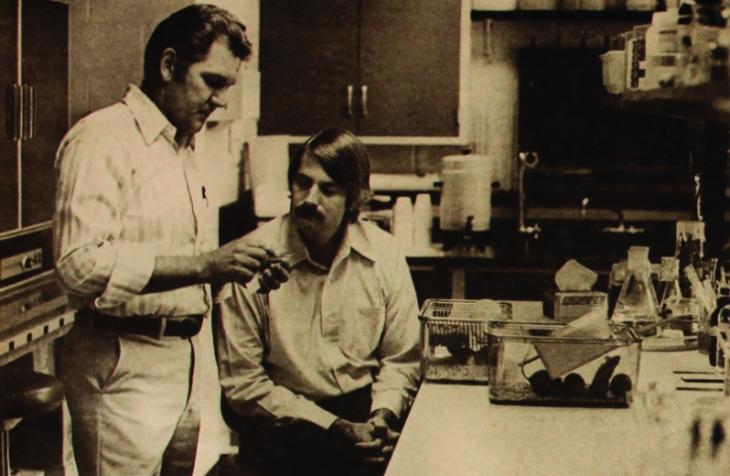40 Things to Know: The world’s first transgenic mammal was developed here
Pictured (from left): Joseph Jollick and Thomas Wagner, both then faculty members at the Heritage College, were part of a research team responsible for a discovery that revolutionized biomedical research.
“It’s because of the way the medical school was founded – different from any osteopathic medical school before it. It changed the standing of osteopathic medicine, and that happened at Ohio University. Period.”
– Thomas Wagner, Ph.D., retired distinguished professor of molecular and cellular biology
Apparently, research really has been in our DNA from the start.
It was in 1980 – just four years after the college opened its doors – that a team led by Thomas E. Wagner, Ph.D., then a chemistry professor on our clinical and basic science faculty, developed DNA microinjection. In this process, an important addition to the genetic engineer’s toolbox, scientists take a gene for a particular trait from one animal and inject it into the embryo of another animal shortly after it’s fertilized. The new gene enters the DNA of the recipient, which can then pass the trait along to its offspring.
This discovery – and Wagner’s use of the process to create the world’s first transgenic mammal by transferring a rabbit gene into a mouse – revolutionized biomedical research, making national news at a time when gene-splicing was still in its infancy. A major collaborator in that research was microbiologist Joseph D. Jollick, Ph.D., who like Wagner was an original member of the college’s science faculty. The patented process of DNA microinjection, developed right here, remains a widely used, powerful tool in genetic medical research.
Wagner, who in 1983 co-founded biotech firm Diagnostic Hybrids Inc. and is now a retired distinguished professor of molecular and cellular biology, is still finding ways to use molecular biology to treat disease. In 2013 he founded Perseus PCI (Personalized Cancer Immuno-therapeutics), a clinic that treats cancer with vaccines made from patients’ own tumor cells.
At a time when the college is developing a comprehensive research strategy to reaffirm its commitment to focused scientific study, it’s worth remembering that our researchers have engaged in world-class work almost from day one. Recalling the earliest days of the college, Wagner stresses that a commitment to hiring top-notch basic science faculty was a hallmark from the start. In turn, he says, the high value placed on research raised the prestige of the college, and ultimately, the entire osteopathic profession.
“It’s because of the way the medical school was founded – different from any osteopathic medical school before it,” Wagner said recently. “It changed the standing of osteopathic medicine, and that happened at Ohio University. Period.”
News coverage about Dr. Wagner’s research:
Ohio University Compass (2014)
The Christian Science Monitor (1992)
The New York Times (1989)
